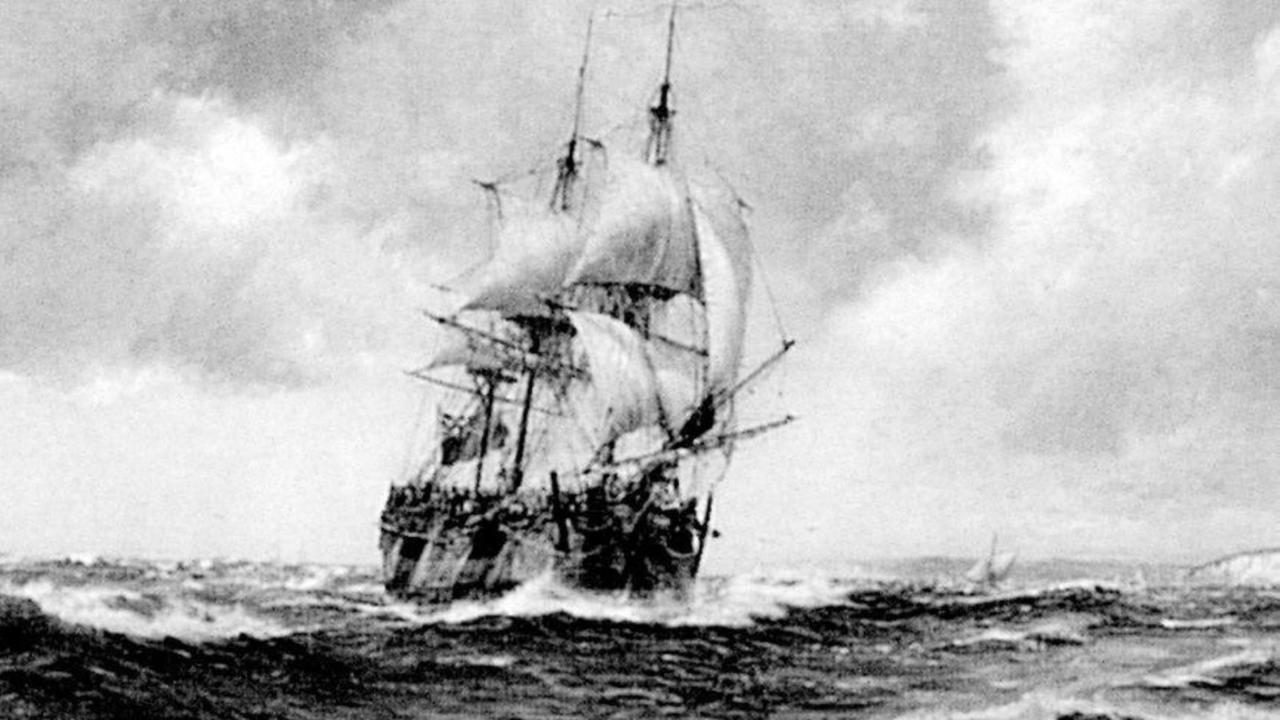
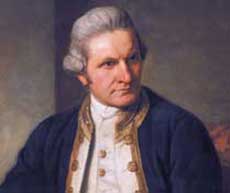 James Cook was born in the Yorkshire village of Marton on October 27, 1728. His first experience at sea came at the age of 18 when he signed on as a deckhand aboard a Whitby collier carrying coal to London. He became an accomplished mathematician in his spare time and was actually offered a command of his own ship but refused and joined the Royal Navy as a seaman.
James Cook was born in the Yorkshire village of Marton on October 27, 1728. His first experience at sea came at the age of 18 when he signed on as a deckhand aboard a Whitby collier carrying coal to London. He became an accomplished mathematician in his spare time and was actually offered a command of his own ship but refused and joined the Royal Navy as a seaman.
His talents were soon recognized and after two years he became master of his own ship, the Pemroke, and was ordered to chart the waters of the St. Lawrence River in Canada. His work was masterful and the Admiralty recalled him to England and placed him in command of the Endeavour which was to take a number of scientists to the Pacific Ocean for observance of Venus.
The Endeavour departed England in 1768 and after visiting Tahiti the following year he came across the coasts of New Zealand and claimed it for Great Britain. Sailing west, in 1770 he sighted the east coast of Australia. From here he sailed north and on August 22 he claimed the whole of eastern Australia as a British possession. The Endeavour returned to England in 1771 having added significantly to Britain's potential empire in the Pacific.
One question remained...whether the unexplored part of the southern hemisphere can only be an immense mass of water or possibly contain another continent. Such speculative geography was a question which had engaged the attention not only of learned men, but of most of the maritime powers of Europe. The British Admiralty decided it was time to find out once and for all. The Admiralty promoted Cook to Commander and was told to prepare for his second voyage.
Cook was instructed to travel south to find Bouvet's Cape Circumcision and determine whether or not it was part of the imagined continent. If so, he was to "take possession of convenient situations in the country in the name of the King of Great Britain". If not part of a continent, then he was to sail as far south as possible, circumnavigate the area and sail north whenever weather and ice made exploration impossible.
The Admiralty outfitted the newly purchased Resolution and Adventure with the Resolution being Cook's flagship. The Resolution was only 110 feet long and 35 feet across the beam. The Adventure was even smaller. With little ceremony the two tiny ships set sail from Plymouth Sound at 6:00 am on July 13, 1772 faced with a three year voyage.
The two ships arrived at Cape Town, South Africa, some 109 days later. Cook soon learned of a voyage to the Indian Ocean by a Frenchman named Yves-Joseph de Kerguelen-Tremarec and of his Discovery of land there which he called La France Australe. It was important news as Cook determined this, like Bouvet's Cape Circumcision, could prove an existence of a southern continent.
On November 23, 1772, Cook sailed out of Cape Town heading into the unknown waters to the south. On December 11 the crew of the Adventure thought they found it. What they actually sighted was an iceberg and by the following day they found themselves at the edge of an endless pack of ice. On January 17, 1773, the ships most likely became the first to cross the Antarctic Circle. For two months Cook sailed alongside the pack, looking for an entrance to travel further south. Cape Circumcision was not to be found where reported and since he was well south of Kerguelen's Discovery Cook determined that Kerguelen's La France Australe could not be part of a southern continent either.
With the onset of winter, Cook sailed north and reached Dusky Sound, on the South Island of New Zealand, on March 25 after sailing some 10,600 miles through uncharted waters. He spent the winter exploring the islands of the South Pacific. During a storm Cook became separated from the Adventure but, nevertheless, sailed south once again on November 27. He once again reached the ice pack, in mid December, and continued his search for a way through to the south.
Cook's skill as a seaman and navigator cannot be challenged...through heavy storms and dangerous seas filled with huge icebergs the Resolution survived without the loss of a single man. On January 30 he reached his furthest south but could go no further.
Cook once again wintered in New Zealand, leaving in November 1774. He sailed across the south Pacific and arrived five weeks later at Tierra del Fuego. He remained for two weeks and then left in a northeasterly direction into the Atlantic.
Although his intentions were to continue to England, his temptation to the south could not be resisted and at the end of January he sighted a group of islands even more desolate than South Georgia. These he named the South Sandwich Islands. After a week of exploration in them, he turned north for England, reaching England on July 30, 1775. The voyage lasted three years and eight days covering more than 60,000 miles. Cook had proved there was no southern continent unless it was at the pole itself.
Cook was promoted again after returning from his second voyage in 1775. He accepted his appointment as Fourth Captain at Greenwich Hospital but with conditions; at 46 years of age he was not ready for this form of retirement so if his country were to call him for more active service or if he felt he could be of an essential service to the public, then he would quit the position. It didn't take long.
The Resolution, now under command of Captain Clerke, was to sail to Tahiti to return a native who had been brought back to England by Tobias Furneaux on the Adventure when it lost contact with Cook's Resolution in the New Zealand storm of 1773. The Adventure was unseaworthy and Cook was asked in early 1776 to find a replacement to accompany the Resolution on the voyage. He recommended another Yorkshire collier, which the Admiralty accepted, renamed it the Discovery and promptly decided to take command of the expedition.
Cook took command, once again, of the Resolution while Clerke was in command of the Discovery. The voyage was to be another sailing of exploration to the Pacific. It was on this voyage that Cook would make his first and only visit to Tasmania. However, this time the route was to be different. Known in England as the Northwest Passage, the route to the Pacific from the Atlantic could only be suspected as all 50 previous attempts at the passage had failed. Discovery of this northerly route to Asia could be significantly quicker than the hazardous route around Cape Horn. Since Cook needed to call at Tahiti, he decided to enter the Pacific from the Indian Ocean, in the process giving him an opportunity to investigate the land discovered by Kerguelen-Tremarec.
Cook and the Resolution left Plymouth on July 12, 1776 with Clerke following a few weeks later in the Discovery. A leaking Resolution arrived in Cape Town on October 18 with the Discovery arriving on the 10th of November. Together they left on November 30th steering southeast in an attempt to locate a group of islands discovered some years earlier by Marion du Fresne. On December 12 they spotted the first of the islands whereby Cook promptly named them the Prince Edward Islands.
Continuing further south, on December 24 they saw land exactly where they expected it to be. The land was an islet off the northwest point of Kerguelen's La France Australe which they encountered later that day. The following day they entered a large bay and anchored near a sandy beach. Crew members went ashore and one of them found a bottle with a note in it containing an inscription in Latin recording the French visits in 1772 and 1773. Cook wrote of his own visit on the same parchment, placed it back in the bottle together with a silver coin and buried it again.
Cook spent four days exploring the island and coastline. While unimpressed due to the lack of trees, shrubs and little grass, there nevertheless was a good supply of fresh water. Cook called them the "Islands of Desolation" although they are known today as the Kerguelen Isles.
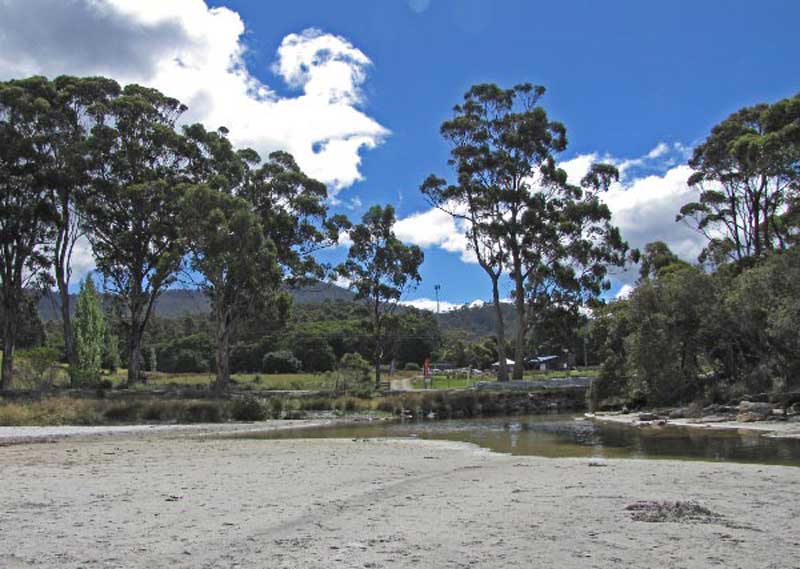
Resolution Creek, Adventure Bay, Tasmania, where Cook and others watered his ships
On December 30, 1776, Cook and Clerke sailed away from the island for New Zealand. This was Cook's last contact with the Antarctic region. On his way to New Zealand, Cook anchored on 26th January 1777 at a locality Furneaux had visited in 1773 and named Adventure Bay. Needing fresh water, wood and grass for the cattle, a party went ashore, ships repairs were also carried out.
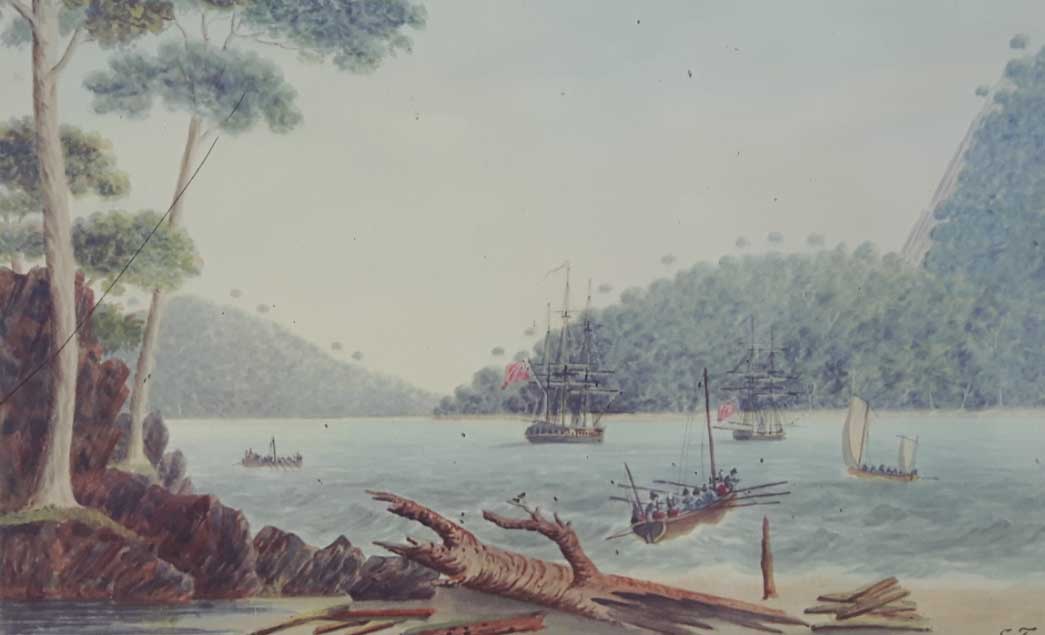
In Adventure Bay, Van Diemen's Land. Painted by Lieut. G. Tobin.
On the third day of Cook's stay, the first Tasmanians were spotted when around ten of them walked along a beach. Cook was on his anchored ship when he received the news and hastened ashore to greet them. After Cook had landed, several of the Tasmanian men came out of the bush and seemed quite unafraid. They also showed no interest in the gifts of beads that Cook offered. Instead, they seemed fascinated by his striped coat. One man held a spear but dropped it when one of the crew gave a friendly sign, coming down from the edge of the wood to the beach with three others, followed soon after by the rest of the group. No violent incidents occurred.
Cook noted: "(They are) of the common stature but rather slender; their skin was black and also their hair, which was as woolly as any native of Guinea, but they were not distinguished by remarkable thick lips nor flat noses, on the contrary, their features were far from disagreeable; they had pretty good eyes and their teeth were tolerable even but very dirty; most of them had their hair and beards anointed with red oinment and some had their faces painted with the same composition."
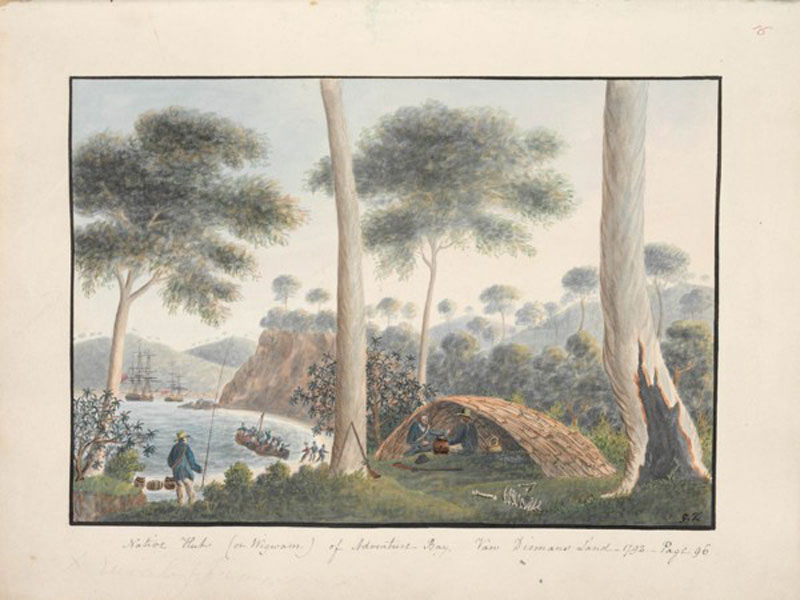
Even though Cook admired them, he did not think the Tasmanians had "sufficient civilization" to justify calling the land occupied since there was no evidence of religion or cultivation of the soil or of a settled law. Cook's view remained accepted wisdom in regard to the Tasmanians among the British - until the British found out how mistaken they were when they tried to occupy and settle the island after 1803.
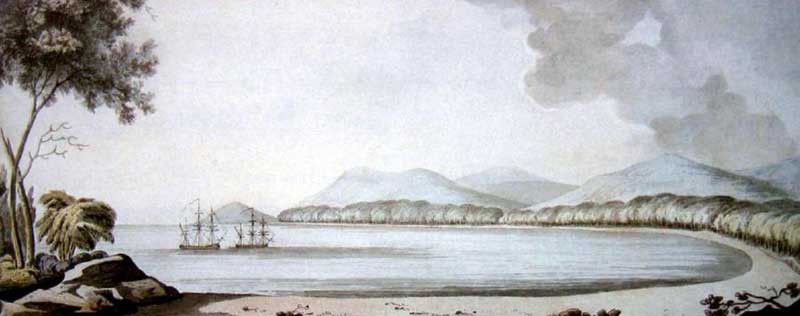
Adventure Bay, Bruny Island, as recorded by William Ellis, surgeon's mate aoard the Discovery in 1777
Below: the same scene today
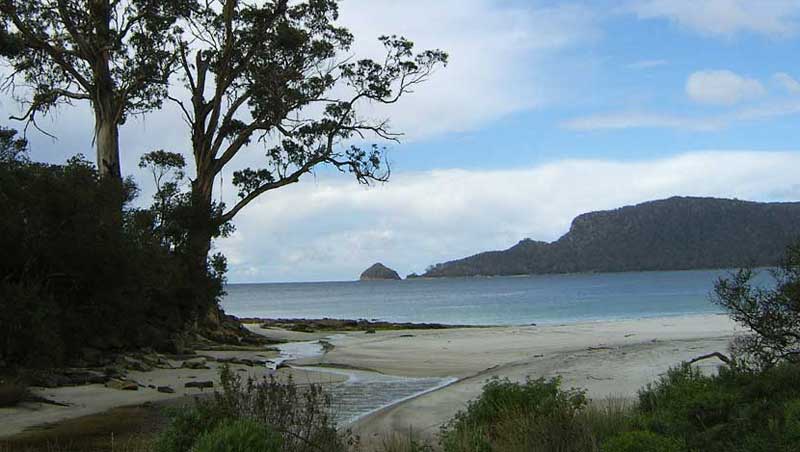
Before leaving, Cook carved his initials in a tree that was destroyed in a 1905 bushfire and is now commemorated by a plaque. Resolution and Discovery weighed anchor and sailed from Adventure Bay at eight o'clock in the morning on the 30th of January 1777. Cook sailed for New Zealand, and was advised to wait until the summer of 1778 before starting his search for the Northwest Passage. On January 18, 1778, Cook made his last great Discovery ... the Hawaiian Islands. For the following month, the two ships sailed north up the west coast of America. Several unsuccessful attempts to locate the passage were tried along the coasts of Canada and Alaska. After sailing through the Bering Strait and crossing the Arctic Circle, Cook abandoned his search and turned both ships south for the Hawaiian Islands.
They reached the islands at the end of November and in the middle of January, 1779, Cook anchored at Kealakekua Bay where he was greeted by thousands of cheering natives. Upon returning to his ship on February 10, Cook discovered a native had stolen one of their boats. Cook went ashore on the 14th with a squad of marines to take the king back to the ship as a hostage.
The king was even willing to go but when they reached the water's edge, a large group of natives stopped them and urged the king not to go. Up the shoreline, a chief was killed while trying to leave the beach and suddenly the mood became very hostile. A native approached Cook in a threatening manner and Cook fired at him. The natives attacked and the marines fired back with guns and bayonets. The battle only lasted a few minutes but when it was over, Cook lay dead on the beach.
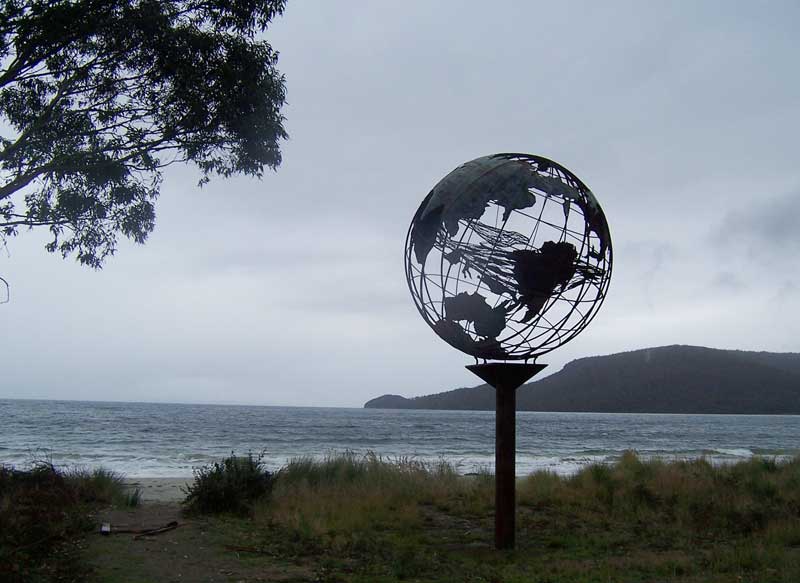
Memorial to British explorers at Adventure Bay, Bruny Island